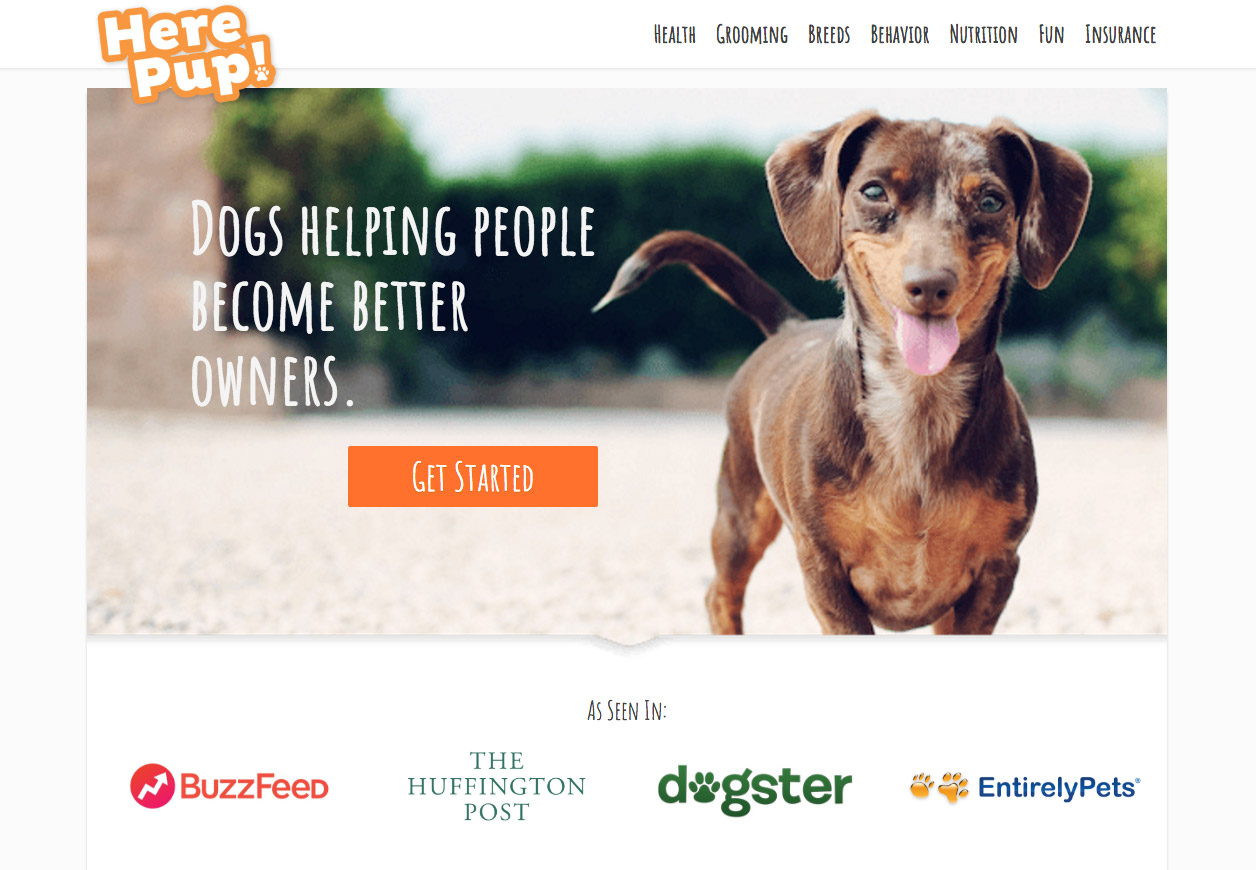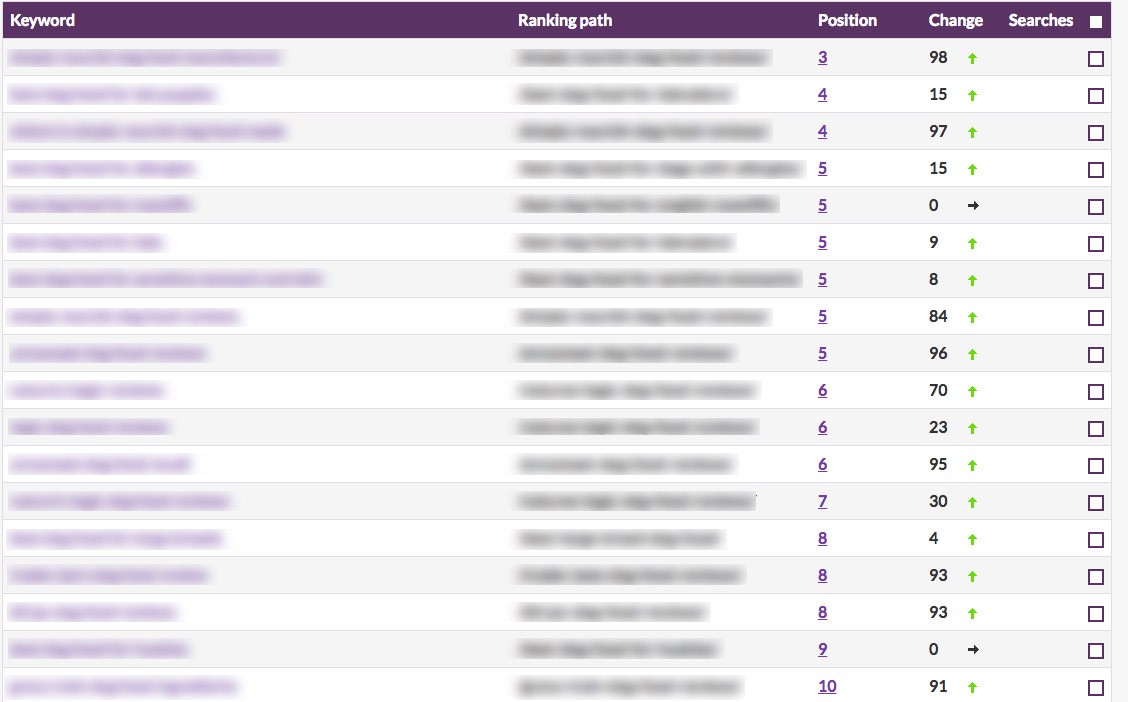How We Doubled HerePup’s Revenue, Visitor Value & Earnings Per Page in 4 Months
Background
In late Sep/early Oct 2016, WiredInvestors purchased HerePup from Perrin Carrell. Those who are in the internet marketing circle might find this name familiar.
Yes, it’s the same Perrin who used to work with Niche Pursuits and is now working with Authority Hacker.
Wired contracted us to build traffic and revenue for HerePup, and in this article, we’ll pull back the curtain and walk you through the background, processes and results of this endeavor.

What is HerePup?
For the uninitiated, HerePup is a content website founded in 2015 that gives dog owners advice on how to care for their pets.
The site relies quite heavily on organic traffic with about 87% of its traffic coming from Google. It tended to experience a peak after Christmas, when people bought pets as presents.
Its strategy was to have an army of original (not spun) keyword-optimized articles on the site. No PBNs were used and the content quality and backlink profile had a clean bill.
 A PBN (Private Blog Network) is a network of websites (under your control) used to build links to your money website in order to rank higher in the Google search engine. Google sees this as a grey/black hat tactic and you risk having your site deindexed.
A PBN (Private Blog Network) is a network of websites (under your control) used to build links to your money website in order to rank higher in the Google search engine. Google sees this as a grey/black hat tactic and you risk having your site deindexed.
When we started work on the site, it mainly earned revenue through Amazon affiliates, Google AdSense (paid per impression) and Media.net advertising.
 Media.net is a contextual ad network with more than 90% of its total revenue coming from the US. Since its tie up with Yahoo! Bing Network, it has been touted as an effective alternative to Google Adsense. Forbes, New York Times, Elle, Reuters, Cosmopolitan and Good Housekeeping are among sites running Media.net ads.
Media.net is a contextual ad network with more than 90% of its total revenue coming from the US. Since its tie up with Yahoo! Bing Network, it has been touted as an effective alternative to Google Adsense. Forbes, New York Times, Elle, Reuters, Cosmopolitan and Good Housekeeping are among sites running Media.net ads.
The business generated the majority of its income from the Amazon affiliate program, promoting dog food specifically.
In our experience, depending on your niche, Amazon affiliates and AdSense were not necessarily always the best way to monetize.
The site also had a mailing list of approx 3000 subscribers but this was a cold list, i.e. subscribers were rarely or never emailed.
Deal Structure
At the point of sale, the site generated $46k in earnings in the last 12 months.

Our goal was to implement a growth plan (details below) and generate over $125k in earnings per year. We believed we could 2x revenue in 12 months.
The Opportunities
Right off the bet, we saw a potential to 2x the revenue in 12 months by:
- Growing traffic
- Increasing organic rankings for highest potential terms through SEO and link building
- Scaling the content production to increase the amount of traffic and potential ranking opportunities
- Changing monetization method
- Switching to a better paying affiliate program
- Introducing high-value upsells eg; pet insurance offers
- Milking the email list
- Focusing on growing the email list in order to promote affiliate programs and brokering email advertising deals
- Improving conversion rates
- Optimizing the page and site layout to maximize visitor value through a higher email optin rate and increasing advertiser/affiliate clicks
What We Focused On
Drilling down further, we decided to hone in on the first two aspects (growing traffic and changing monetization method).
We felt these were quicker wins and matched our available resources then. Also, we didn’t want to spread ourselves too thin by pursuing too many different things at once.
“He who runs after two hares catches neither”
Note:
- We started implementing the changes below in mid/late Oct 2016.
- The baseline number in the charts is the average from Jun to Aug 2016.
I. Growing Traffic
Building More Quality Backlinks
We had the ability and existing resources to scale backlink creation so this was one of the first things we tackled.
For HerePup, we felt that infographics would work well in the pet niche, so we started and focused our link building efforts around infographics.
Here’s the number of infographics we created monthly. Didn’t seem like many, right?

Well, this was because we spent much more time and effort on promoting our infographics. We did a ton of outreach.
 Outreach here refers to an attempt to contact specific blogs/sites to introduce our infographic, in the hope that they’ll publish it and link back to us. We’re placing our bet on sheer numbers of massive scale marketing to drive links, so success hinges on quantity.
Outreach here refers to an attempt to contact specific blogs/sites to introduce our infographic, in the hope that they’ll publish it and link back to us. We’re placing our bet on sheer numbers of massive scale marketing to drive links, so success hinges on quantity.
In Jan alone, we sent and submitted nearly 30k of emails and contact forms combined!

For those who reacted positively, we wrote customized introductions, tailor made for each blog/site, to go with the infographic. So no two blogs/sites have the same introductory paragraph.

The result? We got 54 new links since we started our link building exercise.

The absolute number of links isn’t the whole story though, check out the average DA of the links we got. Even though we only got 1 link in Nov, it came with a DA of 33.
 DA (Domain Authority) is a score developed by Moz that predicts how well a site will rank on search engine results page. It’s calculated by combining various link metrics (eg linking root domains, number of total links) into a single score. The higher the DA, the better.
DA (Domain Authority) is a score developed by Moz that predicts how well a site will rank on search engine results page. It’s calculated by combining various link metrics (eg linking root domains, number of total links) into a single score. The higher the DA, the better.

II. Creating More Content Targeting Keywords
Perrin’s strategy of creating keyword-optimized content worked. And we discovered many more competition keywords we could go after.
Creating keyword-optimized content was something we had lots of experience doing and had existing systems for. We got to work pronto.
Apart from Nov, we published 70+ articles monthly. We optimized all of these articles to rank for keywords.

Every article we published was more than 1000 words long. Thin content just didn’t cut it anymore.

Here’s a screenshot taken on 22 Nov of our new articles ranking within a week of publishing.
Our goal was to quickly improve rankings that were low on the first page or second page. We accomplished that and more!

We started publishing new articles in Nov and they started earning several hundred dollars each month and contributing to our revenue immediately.

Since we’ve taken over the site, we’ve 1.7x earnings per existing page from $20.80 in Sep to $35.90 in Jan.
We calculated the earnings per page by dividing the revenue by the number of pages.

The revenue from new content has been growing each month since we wrote the case study so we expect the earnings per new page to be on an upward trend too.
III. Our Traffic Numbers
Here’s a screenshot from our Google Analytics dashboard. There were a couple of days in Nov when tracking didn’t work, thus the graph showed 0 traffic.

Here’s our traffic broken down by month.

IV. Changing Monetization Methods
Switching to a Better Paying Affiliate Program
We knew of another affiliate program that paid a lot better than Amazon called Chewy so we changed our affiliate program pretty fast once we owned the site!
 Chewy is an online retailer of pet food and other pet-related products based in Florida. The company offers around 30,000 items for dogs and cats and serves the US market. Its primary product is pet food, and it offers a range of options from gourmet to discount food. Other products include leashes, grooming tools, toys, strollers, etc.
Chewy is an online retailer of pet food and other pet-related products based in Florida. The company offers around 30,000 items for dogs and cats and serves the US market. Its primary product is pet food, and it offers a range of options from gourmet to discount food. Other products include leashes, grooming tools, toys, strollers, etc.
We implemented an exit popup with a Chewy coupon in the first month and added Chewy affiliate links to the top pages in Dec.
We also added Chewy affiliate links to some posts which were not monetized.
Due to Amazon’s strong brand recognition, one concern was whether switching from Amazon to another affiliate program might result in fewer clicks.
We didn’t find that to be the case, the total number of clicks hovered around the same level.

Instead of a measly payout rate from Amazon, we negotiated a more attractive payout rate from Chewy.
After the change, we 2x our baseline revenue from $6988 to $14,677 in Jan and we even surpassed our own initial projections!

Here’s the revenue breakdown by program.

Thanks to the increase in revenue, our visitor value also leapfrogged! We 1.8x the visitor value from $0.062 in Sep to $0.114 in Jan.

The visitor values were calculated by dividing the revenue by the number of unique visitors (instead of the number of sessions).
Introducing an Upsell
We also introduced an upsell for pet insurance after any dog food purchase. At the time of writing, this was not a significant contributor to our revenues.
Bottom Line
We bought HerePup in Sep/Oct 2016 and managed to

2x
the baseline revenue

1.8x
the visitor value

1.7x
the earnings per existing page
in 4 months by making these changes:
Here’s what we did:
Growing traffic
- Building more backlinks
- Creating more content targeting keywords
Changing monetization method
- Switching to a higher paying affiliate program
- Introducing an upsell (not a major revenue earner currently)
Moving forward, we’ll:
- Test the upsell to see if we can optimize it better.
- Optimize the page and site layout for more advertiser and affiliate clicks.
- For example, our recent test in March to remove Media.net ads increased the CTR to our affiliates and increased site revenue by $560 for the week.
The goal is to hit $125k earnings per year and it looks like we’re on track!
If you're interested in doubling or tripling your traffic and revenue, we can show you how in our training program. You'll learn our systems and techniques to help websites double their revenues in less than 1 year.
Author Bio
Karen Foo is a deal flow expert and digital marketer with experience in a wide range of industries from finance to education. She is a National University of Singapore Business School graduate and her corporate career spans Europe and Asia. You can tweet her here.
